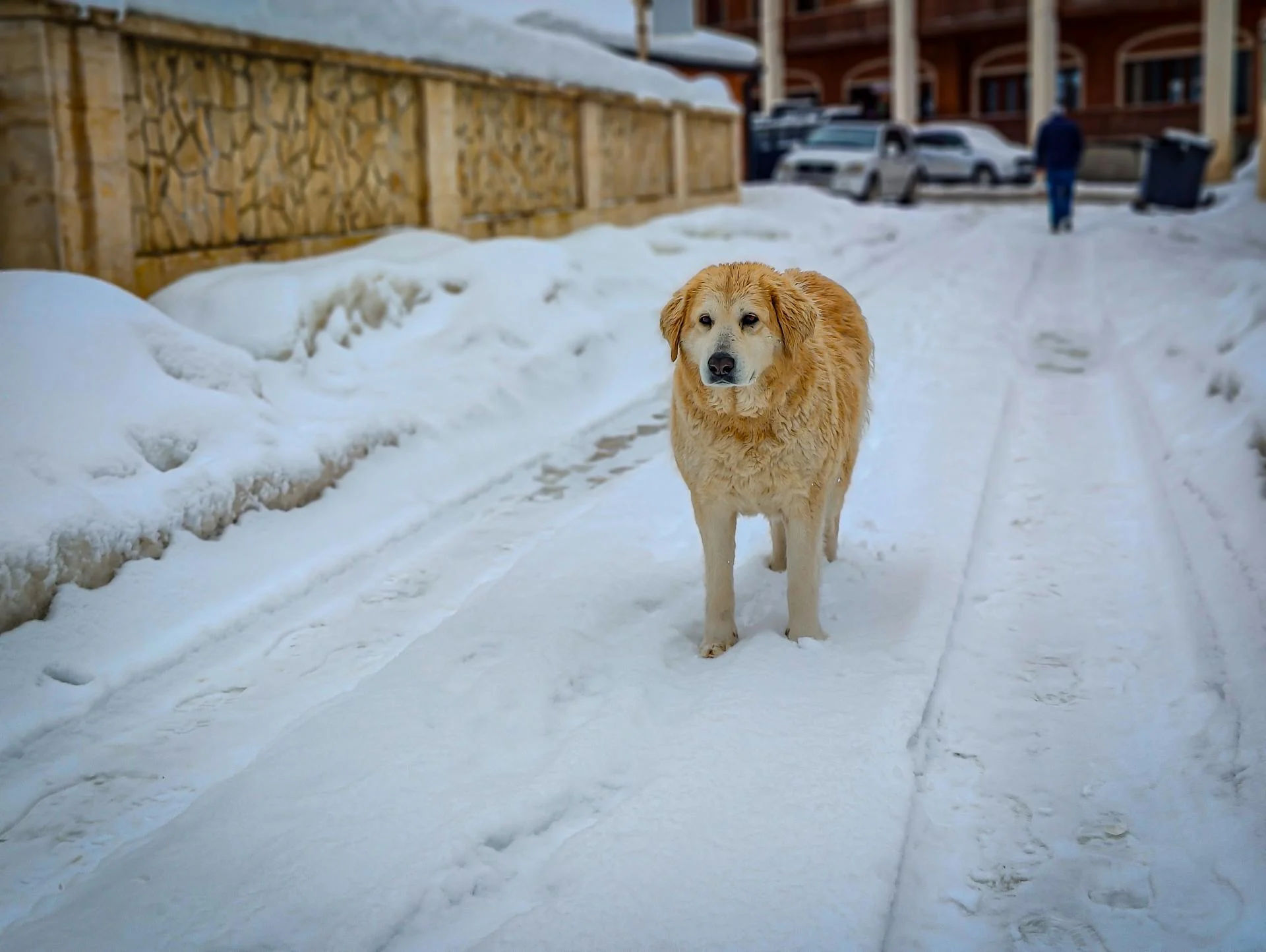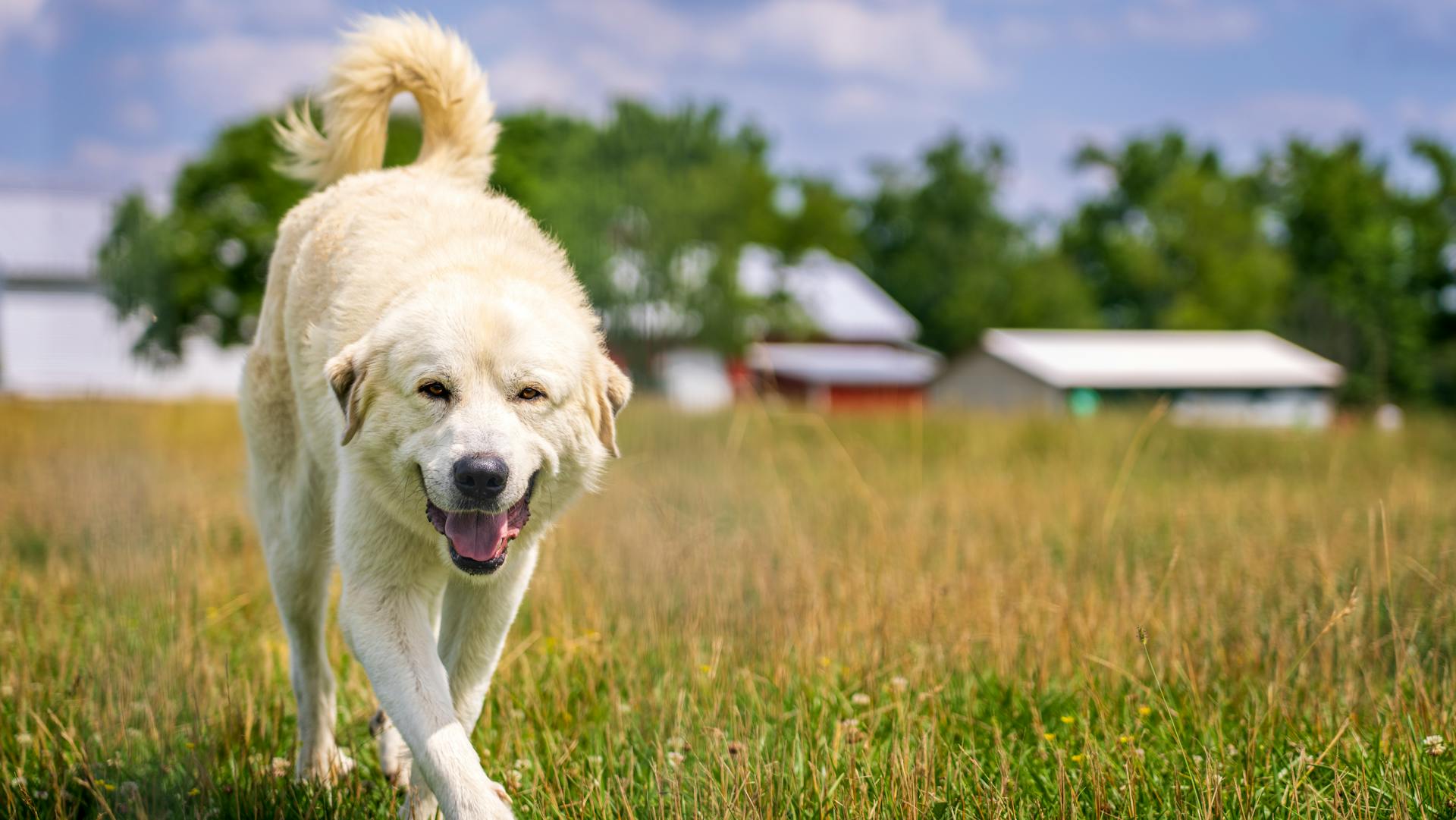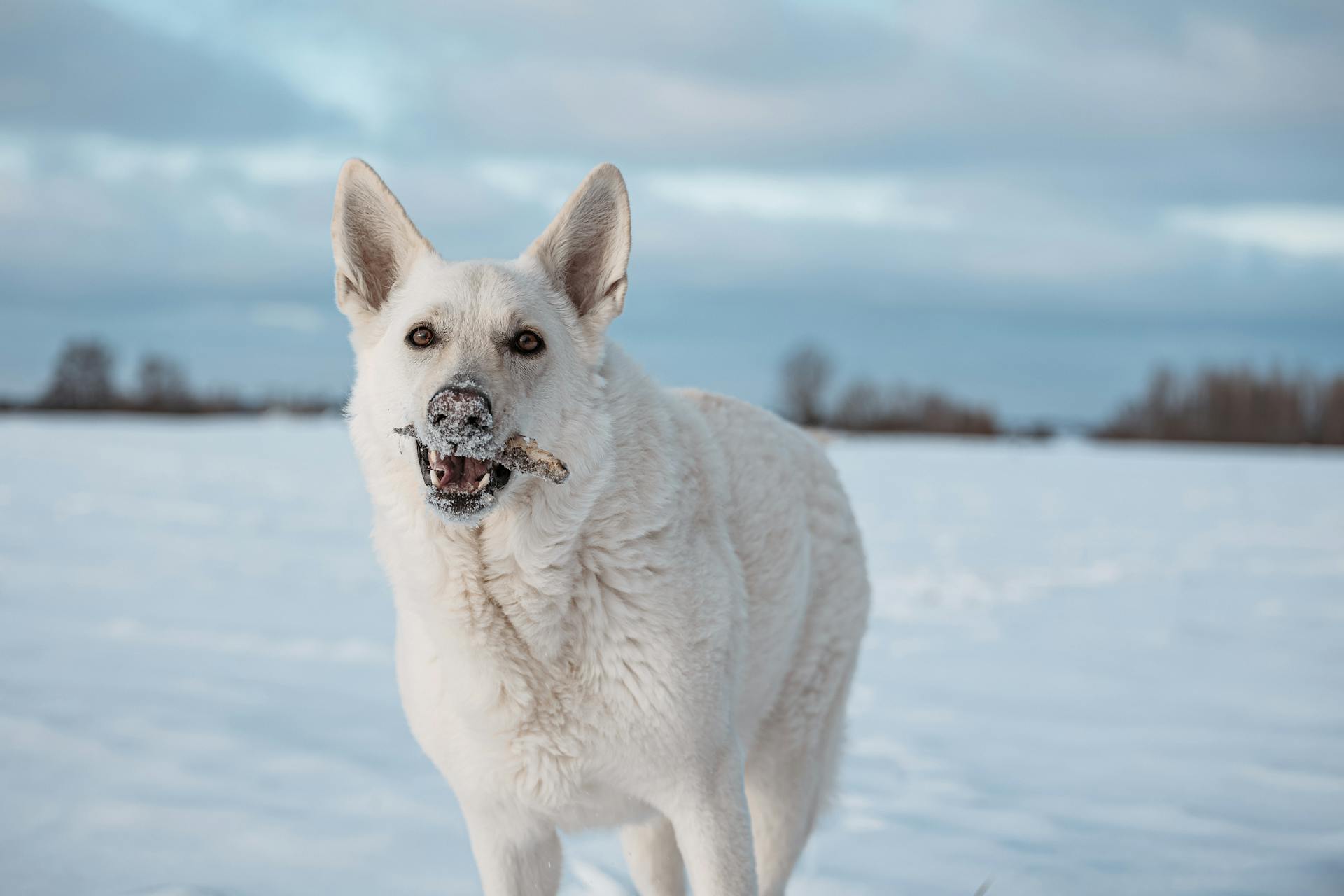
The Great Pyrenees is an ancient breed with a rich history. They originated in the Pyrenees Mountains between France and Spain, where they were used to guard sheep and other livestock.
Their thick coats and gentle nature made them well-suited for this task. They were highly valued by the people of the region for their intelligence, loyalty, and protective instincts.
The Great Pyrenees was first recognized as a distinct breed in the 17th century. They were highly prized by nobility and were often given as gifts to royalty.
Their beautiful white coats and majestic appearance have made them a popular choice as a companion animal.
Expand your knowledge: Is a Great Pyrenees a Giant Breed
Temperament
The Great Pyrenees is a devoted guardian that's wary of strangers. They're naturally protective of their family and can be quite serious at times.
This breed is very gentle with family and children, which makes them a great addition to many households. However, they can be a bit stubborn and independent, which may require some extra patience and effort when training.
As a guardian dog, the Great Pyrenees is a natural barker, so be prepared for some noise. But don't worry, they're generally well-mannered and calm when not provoked.
They're also good with other animals, including cats, which is a bonus for multi-pet households. And, with proper training, they can be surprisingly obedient and eager to please.
Because of their independent nature, they can be a bit willful, which may make training a bit more challenging. But with consistency and positive reinforcement, they can learn to be great companions.
Broaden your view: Great Pyrenees Training
Upkeep
The Great Pyrenees needs daily exercise to stay in shape, a moderate walk usually does the trick.
This breed loves hiking, especially in cold weather and snow, but isn't a fan of hot weather.
Their coat requires brushing once or twice a week, but daily brushing is a must during shedding season.
Some Great Pyrenees dogs may drool at times, so be prepared for a bit of mess.
They can be messy drinkers, so make sure to provide plenty of water and a clean place to drink.
A fresh viewpoint: Why Do Great Pyrenees Bark so Much
Health
The Great Pyrenees is a breed that's generally healthy, but like all breeds, it's not immune to certain health issues. One major concern is CHD, or canine hip dysplasia, which can lead to arthritis and mobility problems.
Here are some potential health issues to be aware of:
- CHD (canine hip dysplasia)
- Patellar luxation (kneecap dislocation)
- Entropion (eyelid issues)
- OCD (osteochondritis dissecans, a joint condition)
- Skin problems
- Osteosarcoma (bone cancer)
- Cataract (eye condition)
- Chondrodysplasia (dwarfism)
- Panosteitis (bone inflammation)
Overall, with proper care and attention, a Great Pyrenees can live a long and healthy life, typically between 10-12 years.
Health Testing
Health testing is crucial for any breed of dog. A thorough examination can help identify potential health issues early on.
The specific health concerns for this breed include major issues like CHD and patellar luxation, as well as minor concerns like entropion, OCD, skin problems, osteosarcoma, cataract, and chondrodysplasia (dwarfism).
Some of these conditions can be identified through suggested tests, such as hip and knee evaluations, and eye exams.
The following tests are recommended for this breed: hip, knee, and eye exams.
Regular check-ups with a veterinarian can help monitor the dog's health and catch any potential issues before they become major problems.
The average life span of this breed is 10-12 years.
Here's an interesting read: Great Pyrenees Skin Problems
Life Expectancy

The average global life expectancy has increased by 5.5 years since 2000, reaching 72 years in 2019, according to the World Health Organization.
This increase is largely due to improvements in healthcare and a decrease in infant mortality rates.
In fact, the number of children dying before their fifth birthday decreased by 53% between 1990 and 2019.
However, life expectancy varies greatly depending on where you live, with people in Japan and Singapore living up to 85 years or more on average.
In contrast, countries with limited access to healthcare and sanitation, such as Chad and Somalia, have a life expectancy of less than 60 years.
A healthy diet and regular exercise can also play a significant role in increasing life expectancy, with studies showing that people who eat a balanced diet and exercise regularly can live up to 7 years longer than those who don't.
You might enjoy: Can Great Pyrenees Live outside
Hydration
Drinking enough water is crucial for our bodies to function properly, and the recommended daily intake is about 8 cups or 64 ounces.

Dehydration can lead to headaches, fatigue, and difficulty concentrating, which can be a significant distraction in our daily lives.
Even mild dehydration can cause a 12% decrease in cognitive performance, making it harder to stay focused and alert.
Not drinking enough water can also cause our skin to lose its elasticity and become dry, leading to premature aging.
Drinking water regularly can help to flush out toxins and waste products from our bodies, which can improve our overall health and wellbeing.
In fact, drinking enough water can even help to regulate our body temperature, which is essential for maintaining our physical and mental health.
Discover more: Great Pyrenees Health Problems
History
The Great Pyrenees is a very old breed that likely descended from the first flock guardian dogs in Asia Minor around 10,000 b.c. These dogs were large white dogs that existed in Asia Minor.
The breed's origins can be traced back to the Pyrenees Mountains, where nomadic shepherds brought their flock guarding dogs around 3000 b.c. The dogs excelled as livestock guardians for several centuries.
Broaden your view: Dogs Similar to Great Pyrenees
The Great Pyrenees became a formidable fortress guard in medieval France and caught the eye of French nobility in the late 1600s. They were even decreed the "Royal Dog of France" by Louis XIV in 1675.
The breed was introduced to Newfoundland, where they may have played a role in the development of the Newfoundland breed. The first documented Pyrenees came to America with General Lafayette in 1824.
Related reading: Great Pyrenees Mixed with Newfoundland
Introduction to the US
The Great Pyrenees breed was first introduced to the US in the early 20th century. In 1931, Mr. and Mrs. Francis V. Crane founded the Basquaerie Kennels in Needham, Massachusetts, and imported several specimens to seriously launch the breed in North America.
They imported important breeding stock out of Europe just before World War II closed the Continent, setting the stage for the breed's growth in the US. The American Kennel Club accorded the Great Pyrenees official recognition in February 1933.
Related reading: Great Pyrenees Breed Standard

The breed quickly gained popularity, and separate classification for the breed began at licensed shows in April 1933. Today, the Great Pyrenees is a beloved companion and family dog, known for its versatility and ability to adapt to various situations.
They are trusted members of homes and may function as livestock guardian dogs on farms and ranches. With their gentle nature, they get along extremely well with other animals, making them a great addition to families with multiple pets.
A Peasant's Dog
The Great Pyrenees is a mountain shepherd's dog that developed a special relationship with the shepherd, its family, and the flock.
Over this long period of time, the Great Pyrenees became a valuable asset to the shepherds, with its precocious sense of smell and exceptionally keen eyesight making it equivalent to two men.
In 1675, the Great Pyrenees was adopted as the Royal Dog of France by the Dauphin in the court of King Louis XIV, and subsequently became much sought after by nobility.
The Great Pyrenees' main fame was from its ageless devotion to its mountain flocks, shepherds, and shepherds' family.
When not working the flocks, you would find the Great Pyrenees laying on the mat in the front doorway of the shepherds' humble dwellings, affectionately known as "Patou".
Broaden your view: Leonberger Bernese Mountain Dog
Featured Images: pexels.com


